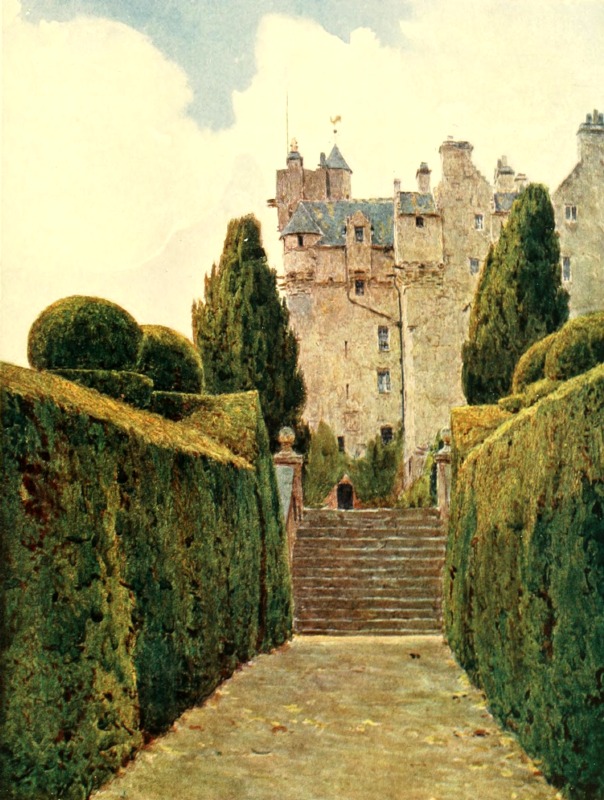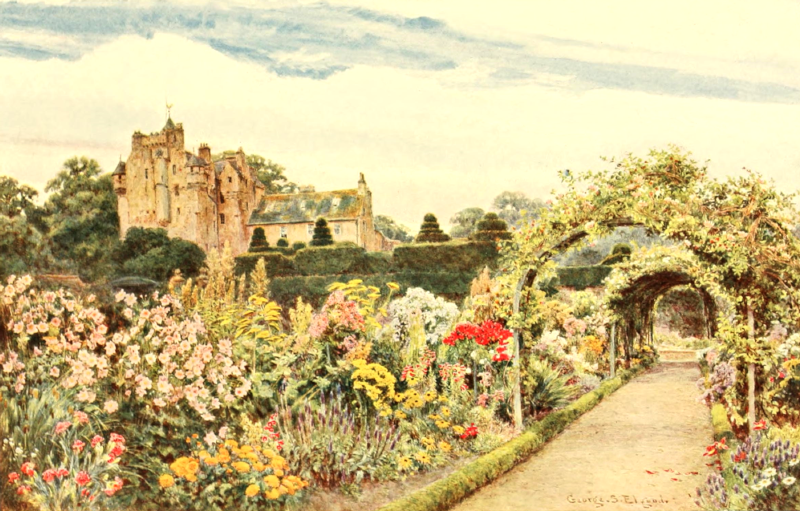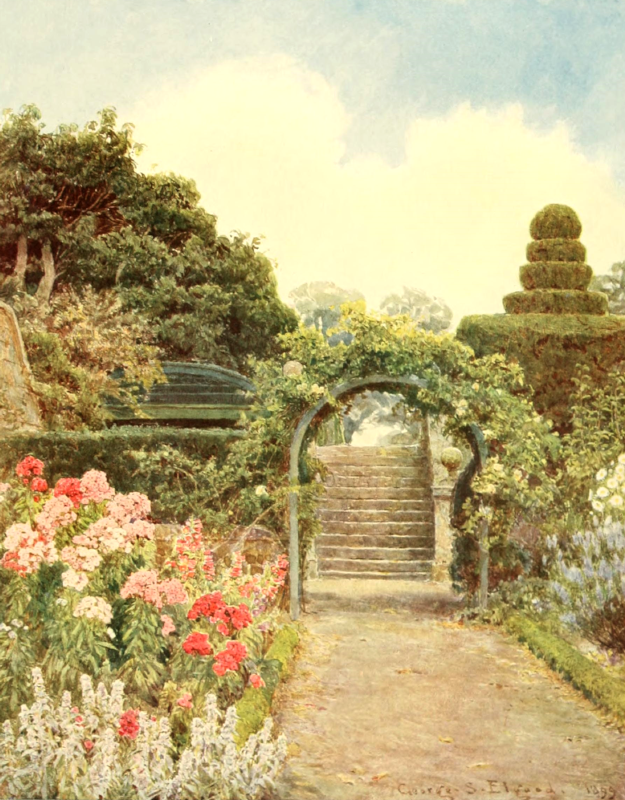| Web
and Book design,
Copyright, Kellscraft Studio 1999-2021 (Return to Web Text-ures) |
 (HOME)
|
|
CRATHES
CASTLE
Crathes
Castle in Kincardineshire presents one of the finest examples of Scottish
architecture of the sixteenth century. It is the seat of Sir Robert Burnett of
Leys, the eleventh baronet and descendant of the founder. Profoundly
impressive are these great northern buildings, rising straight and tall out of
the very earth. As to their lower walls, they are grim, forbidding, almost
fiercely repellent. There is an aspect of something like ruthless cruelty in
the very way they come out of the ground, without base or plinth or any such
amenity — built in the old barbarous days of frequent raiding and fighting, and
constant need of protection from marauders; when a man's house must needs be a
strong place of defence. This
is the first impression. But the eye travelling upward sees the frowning wall
blossom out above into what has the semblance of a fairy palace. It is like a
straight, tall, rough-barked tree crowned with fairest bloom and tenderest
foliage. Turrets both round and square, as if in obedience to the commanding
wave of a magician's wand, spring out of the angles of the building and hang
with marvellous grace of poise over the abyss. There seems to be no actual
plan, and yet there is perfect harmony; the whole beautiful mass appears as if
it had come into being in some one far-away, wonderful, magical night! It is a
sight full of glamour and romantic impression — grim fortalice below, ethereal
fantasy aloft. Rough and rugged is the rock-like wall, standing dark and dim in
the evening gloom; intangible, opalescent are the mystic forms above, in the
tender warmth of the afterglow; cloud-coloured, faintly rosy, with shadows
pearly-blue.

THE YEW WALK, CRATHES From the picture in the possession of Mr. Charles P. Rowley Direct
descendants of the old Norman keep, these Scottish castles, for the most part,
retain the four-sided tower, as to the main portion of the structure. The walls
need no buttresses, for they are of immense thickness, and the vaulted masonry,
usually of the simple barrel form, that carries the floors of, at any rate, the
lower stories, ties the whole structure together. The angle turrets carried on
bold corbels that are so conspicuous a feature of these northern castles, broke
away from the Norman forms and became a distinct character of the Scottish
work. They were a helpful addition to the means of defence, and, as long as
they were built for use, added much to the beauty and dignity of the structure.
The only detail that shows a tendency to debasement in Crathes is the quantity
of useless cannon-shaped gargoyles, put for ornament only, in places where they
could not possibly do their legitimate work of carrying off rain-water from the
roof. There
could have been no pleasure garden in the old days; but now these ancient
strongholds, mellowed by the centuries, seem grateful for the added beauty of
good gardening. The grand yew hedges may be of the seventeenth century. They
stand up solid and massive for ten feet or more, with roof-shaped tops, and
then rise again at intervals into great blocks, bearing ornaments like circular
steps crowned with a ball. The ornament is simpler, a low block and ball only,
in the first picture, where they accentuate the arches that lead right and left
into the two divisions of the flower garden. This plainer form is perhaps more
suitable to this grand old place than the more elaborate, just because it is
simpler and more dignified. The
flower garden, as it is to-day, is quite modern. The finest of the hardy
flowers are well grown in bold groups. Luxuriant are the masses of Phlox and
tall Pyrethrum, of towering Rudbeckia, of Bocconia, now in seed-pod but
scarcely less handsome than when in bloom; of the bold yellow Tansy and Japan
Anemones; all telling, by their size and vigour, of a strong loamy soil. Many
are the arches of cluster and other climbing Roses; at one point in the kitchen
garden coming near enough together to make a tunnel-like effect. Wonderful
is the colouring and diversity of texture! — the bright flowers, the rich, dark
velvet of the half-distant yews, the weather-worn granite and rough-cast of the
great building. If
the flowers in the second and third pictures were in our southern counties the
time would be the end of August or at latest the middle of September, but the
seasons of the flowers in Scotland are much later, and these would be October
borders. The
Castle stands upon a wide, level, grassy terrace, which is stopped on the
north-eastern side by the parapet of a retaining wall, broken by a flight of
steps down to the path that is bounded by the two hedges of ancient yews shown
in the first picture. These hedges divide the flower garden into two equal
parts on the lower level, for, from where the Castle stands, the ground falls
to the south and east. On each side of the steps, just beneath the terrace
wall, is a flower border. Immediately on entering the double wall of yew there
is an opening to right and left — an arch cut in the living green — giving
access to the two square gardens, in both of which a path passes all round next
the yews. There is also a flower border on two sides. The middle space is grass
with flower beds; in the left-hand garden (coming from the Castle) are bold masses
of herbaceous plants in beds grouped round a fountain; in the one on the right,
for the most part, Roses and Lilies. To
the south-east, and occupying the space next beyond the rose garden and the end
of the lawn adjoining the Castle, is the kitchen garden. The main walks have
flower borders. Where the two cross paths intersect is a Mulberry tree with an encircling
seat. The subjects of the second and third pictures are within the kitchen
garden. Many
are the beautiful points of view from the kitchen garden, for there the grand
yew hedges show beyond the flowers; then, towering aloft, comes the fairy
castle, and then fine trees; for trees are all around, closely approaching the
garden's boundaries. 
CRATHES From the picture in the possession of Mr. George C. Bompas It is
one of the wholesomest of fruits; its better sorts of truly delicious flavour.
It is a pleasure, to one who knows its merits, to extol them. It is essentially
a fruit for one who loves a garden, because, for some reason difficult to
define, it is less enjoyable when brought to table in a dessert dish. It should
be sought for in the garden ground and eaten direct from the bush. Perhaps many
people are deterred by its spiny armature, and it is certain that, when, as is
too often the case, the bushes are in crowded rows and have been allowed to
grow to a large size, the berries are difficult to get at. But
the true amateur of this capital autumn fruit has them in espalier form, in a
few short rows, with ample space — about six feet — between each row. The
plants may be had ready trained in espalier shape, but it is almost as easy to
train them from the usual bush form. The vigorous young growth that will spring
out every year is cut away at the sides in middle summer; just a shoot or two
of young wood being left, when the bushes have grown to a fair size, to train
in, to take the place of older wood. The plants being restricted to the fewer
branches that form the flat espalier, more strength is thrown into the ones
that remain, so that the berries become larger; and, as plenty of light and sun
can get to the fruits, even the best kinds are sweeter and better flavoured
than when they are allowed to grow in dense bushes. Then
when the kinds are ripe how pleasant it is to take a low seat and sit at ease
before each good sort in succession! The best and ripest fruits can be seen at
a glance and picked without trouble, in pleasant contrast to the painful,
prickly groping that goes on among the crowded bushes. No one would ever regret
planting such excellent sorts as Red Champagne, Amber Yellow, Cheshire Lass,
Jolly Painter, a large, well-flavoured and little-known berry, and Red
Warrington, a trusty late kind. To these should be added two admirable
Gooseberries lately brought out by Messrs. Veitch, namely, Langley Green and
Langley Gage, both fine fruits of delicious flavour. If
such a little special fruit space were planted in these large Scottish gardens,
and the merits of the kinds became known, the daily invitation of the hostess,
"Let us go to the gooseberry garden," would be gladly welcomed, and
guests would also find themselves, at various times of day, sauntering towards
the gooseberry plot. How
grandly the scarlet Tropćolum (T. speciosum) grows in these northern
gardens is well known; indeed, in many places it has become almost a pest. It
is much more difficult to grow in the South, where it is often a failure; in
any case, it insists on a northern or eastern exposure. Where it does best in
gardens in the English counties is in deep, cool soil, thoroughly enriched.
When well established, the running roots ramble in all directions, fresh
growths appearing many feet away from the place where it was originally
planted. It looks perhaps best when running up the face of a yew hedge, when
the bright scarlet bloom, and leaves of clear-cut shape, are seen to great
advantage, and many of the free growths of the plant take the form of hanging
garlands.  CRATHES: PHLOX From the picture in the possession of Mrs. Croft |